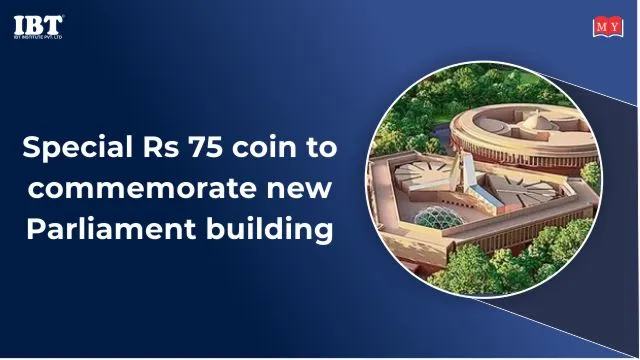
Special Rs 75 coin to commemorate the new Parliament building
India has been issuing commemorative coins since the 1960s for several reasons such as paying homage to notable personalities, spreading awareness about government schemes, or remembering key historic events.To mark the inauguration of the new Parliament building, Prime Minister Narendra Modi released a commemorative coin of Rs 75 denomination on Sunday (May 28).
About the new coin:
one side of the coin will feature the Lion Capital of the Ashoka Pillar, with the words "Satyamev Jayate" below it while the word "Bharat" will be written in Devanagari script on the left side, and the word "India" in English on the right. The coin will also include the rupee symbol and the denomination value of 75 in international numerals written below the Lion Capital.
The other side of the coin will show an image of the parliament complex.The words "Sansad Sankul" will be written in Devanagari script on the upper periphery and "Parliament Complex" in English on the lower periphery. The shape of the coin will be circular with a diameter of 44 millimeters and will have 200 serrations along its edges. The 35-gram coin will be made from a four-part alloy, which includes 50% silver, 40% copper, 5% nickel, and 5% zinc.
Significance of the Coin:
The issuance of the ₹75 coin holds great symbolic importance as it pays tribute to India’s 75 years of independence. The Lion Capital, a national emblem of India, represents strength, courage, and righteousness. The inclusion of the parliament complex highlights the significance of the new building and its role as a center of democracy.
Specifications and Composition
The circular coin will have a diameter of 44 millimeters and 200 serrations along its edges. It will weigh 35 grams and be composed of a four-part alloy, consisting of 50% silver, 40% copper, 5% nickel, and 5% zinc. The use of silver in the composition adds a precious and commemorative element to the coin.
New Parliament Building
The new Parliament building will be the first purpose-designed Parliament building for India. It will house larger Lok Sabha and Rajya Sabha halls, with capacities of 770 seats and 384 seats respectively. The Lok Sabha hall will also have additional capacity, up to 1140 seats, to host joint sessions. Along with essential facilities like committee rooms, major offices of the Ministry of Parliamentary Affairs, Lok Sabha Secretariat and Rajya Sabha Secretariat, the building will also include publicly accessible museum-grade galleries and exhibits. The central Constitution Hall and Gallery will showcase the Indian Constitution and other artefacts of India’s heritage, symbolically and physically putting people at the heart of the Indian democracy.
The design of the new Parliament building will incorporate state-of-the-art infrastructure and technology to assist the Parliament’s functions. Furniture in the debating halls will include smart displays and biometrics for ease of voting with intuitive and graphical interface; digital language interpretation and recording infrastructure to produce real-time metadata; and programmable microphones.
The new Parliament building will work in conjunction with the present Parliament building. Its design takes reference from the present Parliament building, and other historical buildings of the Central Vista. It will also reflect the classical, folk and tribal arts and crafts of India. The National Emblem will crown the new Parliament building.
 4.5/5
4.5/5








